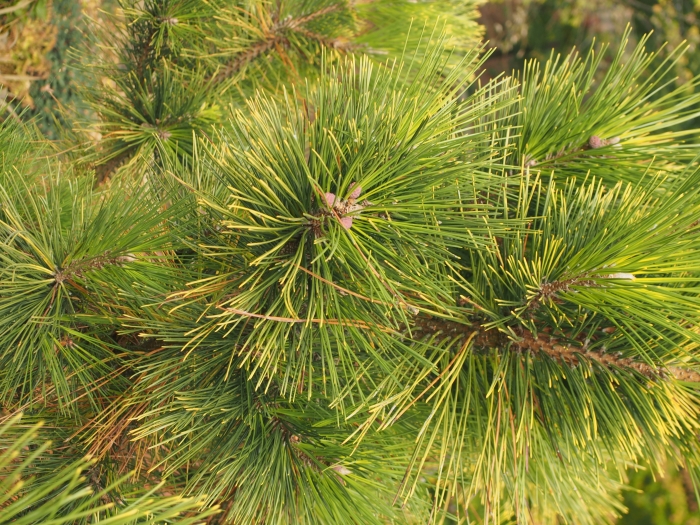Japanese Black Pine
(Pinus thunbergii)
Japanese Black Pine (Pinus thunbergii)
/
/

Agnieszka Kwiecień, Nova
CC BY-SA 4.0
Image By:
Agnieszka Kwiecień, Nova
Recorded By:
Copyright:
CC BY-SA 4.0
Copyright Notice:
Photo by: Agnieszka Kwiecień, Nova | License Type: CC BY-SA 4.0 | License URL: https://creativecommons.org/licenses/by-sa/4.0 | Uploader: Nova | Publisher: Wikimedia Commons | Title: Pinus_thunbergii_'Ogon'_Sosna_Thunberga_2021-10-16_04.jpg | Notes: Uploaded own work with UploadWizard |



























































Estimated Native Range
Summary
Pinus thunbergii, commonly known as Japanese Black Pine, is an evergreen tree native to coastal areas and pine forests in Japan and Korea, where it often endures harsh conditions such as strong winds and salt spray. It typically reaches heights of 20-40 meters in its natural habitat but is usually smaller in cultivation. The tree’s needles are dark green, stiff, and paired in fascicles of two, measuring 7–12 cm in length, with a distinctive white sheath at the base. Female cones are 4–7 cm long, with a prickly appearance due to small points on the scale tips, and require two years to mature. Male cones are smaller, 1–2 cm long, and appear in clusters. The bark is initially gray on young trees and small branches but becomes black and deeply furrowed with age.
Japanese Black Pine is valued for its rugged appearance, with attractive dark green foliage that contrasts sharply against the often-black, plated bark. It is a versatile tree used in various landscape settings, including urban environments, due to its tolerance to pollution and salt. It is also a classic choice for bonsai and traditional Japanese Niwaki pruning. This pine prefers full sun and can adapt to a range of soil conditions, from slow to medium drainage, but it thrives best in well-drained sandy soils. Regular watering is necessary, especially in drier climates. While generally pest-resistant, it can be susceptible to pine wilt disease and certain fungal infections.CC BY-SA 4.0
Japanese Black Pine is valued for its rugged appearance, with attractive dark green foliage that contrasts sharply against the often-black, plated bark. It is a versatile tree used in various landscape settings, including urban environments, due to its tolerance to pollution and salt. It is also a classic choice for bonsai and traditional Japanese Niwaki pruning. This pine prefers full sun and can adapt to a range of soil conditions, from slow to medium drainage, but it thrives best in well-drained sandy soils. Regular watering is necessary, especially in drier climates. While generally pest-resistant, it can be susceptible to pine wilt disease and certain fungal infections.CC BY-SA 4.0
Plant Description
- Plant Type: Tree
- Height: 20-60 feet
- Width: 12-20 feet
- Growth Rate: Rapid
- Flower Color: N/A
- Flowering Season: Non-Flowering
- Leaf Retention: Evergreen
Growth Requirements
- Sun: Full Sun
- Water: Medium
- Drainage: Medium, Slow
Common Uses
Bank Stabilization, Bird Garden, Border Plant, Deer Resistant, Drought Tolerant, Erosion Control, Fragrant, Hedges, Low Maintenance, Rabbit Resistant, Rock Garden, Salt Tolerant, Street Planting
Natural Habitat
Coastal areas and pine forests in Japan and Korea
Other Names
Common Names: Black Pine , Japanese Pine , Japanische Schwarzkiefer , Thunbergs Kiefer , Pino Di Thunberg , 곰솔 , Green Pine , Kuro-Matsu , Hei Song , Haesong
Scientific Names: Pinus thunbergii , Pinus thunbergiana , Pinus massoniana , Pinus thunbergii var. oculus-draconis , Pinus thunbergii f. oculus-draconis , Pinus thunbergii var. pendula
GBIF Accepted Name: Pinus thunbergii Parl.